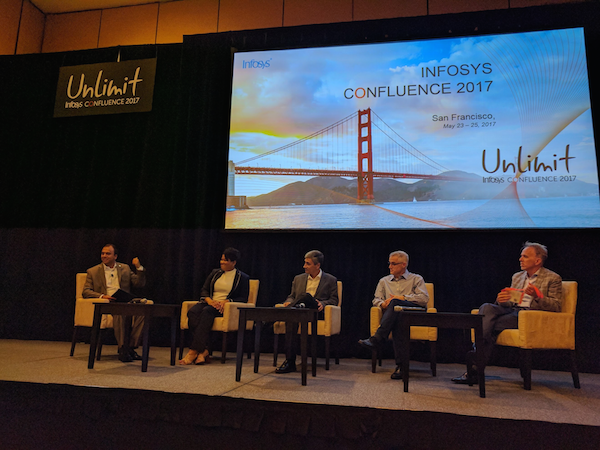Automation, AI and the Human Factor
In late May, I was invited to participate on a panel discussion at the Infosys Confluence conference. The panel’s topic was automation and AI and it was moderated by Rajesh Murthy, Infosys’ president and head of services for its communications and energy division. Rajesh wanted to hear from myself and the other panelists about how automation and AI were effecting our organizations as we implemented these technologies to improve the performance of our products and services.
While much has been said about the potential economic impact of these technologies, Rajesh was interested in hearing about how AI and automation were effecting employees at a human level. Frankly, he felt there was a lot of FUD circulating today around automation and AI and how these technologies will leave millions unemployed as robots replace the human workforce.

My fellow panelists and I believe that while automation and the ability for machines to learn how to improve their own performance does promise revolutionary changes to the workforce, we are still years away from a wholly-automated experience that truly meets user expectations (and leaves us all unemployed). To illustrate the challenges involved in bringing new automated systems on line, getting them to behave as intended and teaching to work better over time, Rajesh screened a clip from Charlie Chaplin’s silent classic, Modern Times(1936).
It’s a funny clip, and despite being made almost eighty years before the rise of the IoT and machine learning, it did touch on several problems the technology industry must address if automation and AI are going to deliver on their full potential.
Machines are Fast, But Not Smart
While Chaplin’s eating machine was certainly fast, it wasn’t aware of its operating environment and conditions. It blindly continued to shove food into Chaplin’s mouth at a pace too fast for normal eating and was unaware when non-food items were put on the plate. Today’s connected systems are very fast thanks to Moore’s Law and the wide availability of broadband Internet connectivity, but they lack the intelligence not only to spot when they’re performing outside of normal operating conditions, but also to take steps to remedy the problem without asking for a human to help. Here at HPCC Systems, it’s a problem we’re looking to address through our smart data concept, which leverages the computational resources available to many IoT-enabled devices (smartphones, for example) to conduct data analysis at the endpoint, without the need to first warehouse and analyze data in a virtual or on-premises datacenter. This accelerates the machine’s ability to change itself to operate more efficiently.
Humans Drive the Domain
Now, the panel agreed that automation and AI have the potential to make much of the human workforce obsolete, particularly workers performing repetitive and relatively simple procedures (a manufacturing production line, for example). However, machines are still years away from being able to handle more advanced tasks on their own. The kind of experience-based learning that makes humans experts in a specific field is very difficult to recreate in machines, and domain-specific expertise is still largely exclusive to humans. Until we develop the algorithms that can make accurate calculations based on past activity, more advanced processes will still require continual oversight and maintenance by humans.
Automation and AI Let Organizations Focus on Their Value Add
Here at HPCC Systems, our core mission is to create software that provides fast, accurate, data-driven decisions in a way that’s unobtrusive to the customer. For example, the HPCC Systems software is helping online car insurance companies deliver custom rate quotes in real time based on an individual’s specific driving record. The backend work involved in making that experience happen is daunting: it requires accessing multiple databases, extracting the relevant data, formatting it for use and then calculating a rate, all of which must happen within seconds of an end user making the ask. By automating that process in software, we let our customers spend less time wrestling with the logistics involved in handling and processing data (our domain expertise) and more time applying their decades of experience in the auto insurance business, finding ways to improve their product and service offerings (their domain expertise). In other words, automation and AI won’t replace the workforce, but rather will allow the workforce to focus more on innovation and less on implementation.
